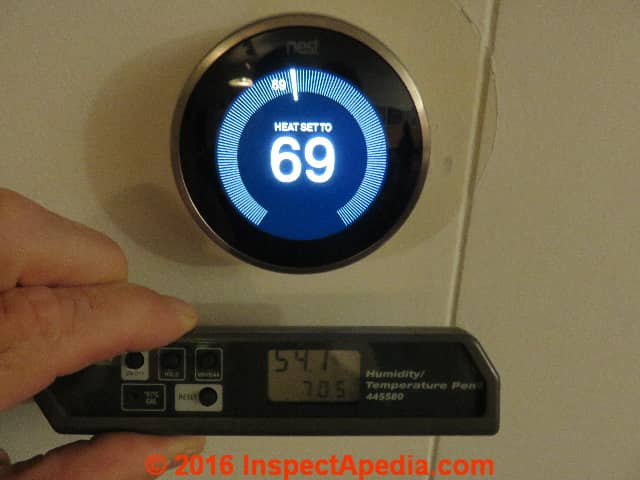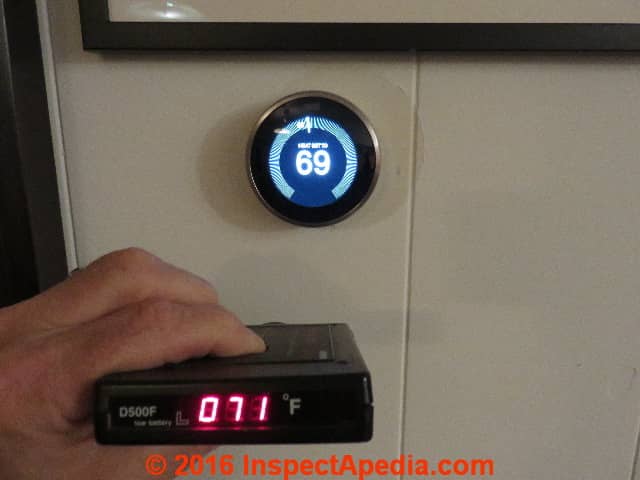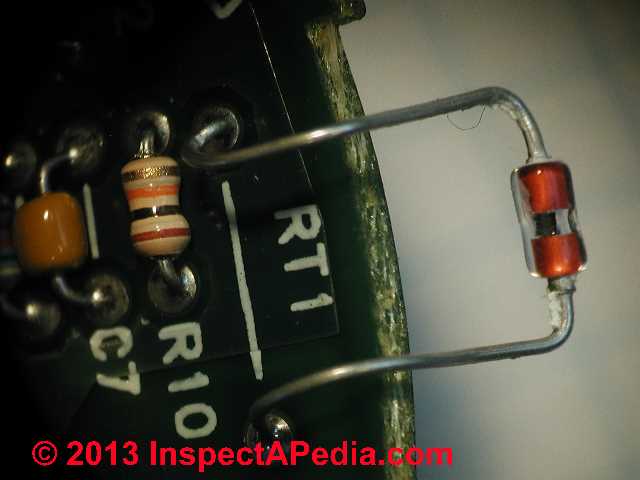 Accuracy of Nest Room Thermostat Humidity Indicator
Accuracy of Nest Room Thermostat Humidity Indicator
What affects the accuracy of humidity measurements
- POST a QUESTION or COMMENT about humidistats, humidity measurement accuracy, Nest thermostat humidity reading, & heating and air conditioning thermostat operating properties
Accuracy of the Nest thermostat's humidity reading and accuracy of other room humidity measurements:
How accurate is the humidity reading provided by the Nest room thermostat and what conditions affect the accuracy of any room thermostat or humidistat?
We made real-time highly-accurate humidity and temperature measurements to compare with the humidity and relative readings of the Nest Thermostat.
Page top photo: measuring relative humidity at the building wall where a Nest 3 room thermostat has been installed.
InspectAPedia tolerates no conflicts of interest. We have no relationship with advertisers, products, or services discussed at this website.
- Daniel Friedman, Publisher/Editor/Author - See WHO ARE WE?
Room Thermostat or Humidistat Accuracy & Response to Indoor Humidity
 Reader Question: humidity & temperature in room vs. in wall vs. Nest thermostat response
Reader Question: humidity & temperature in room vs. in wall vs. Nest thermostat response
2016/08/22 Anonymous wrote [by private email]
Can you tell me what the difference in humidity % in the house would be as opposed to inside the wall?
It seems the portable dehumidifier is reading 45%, but their Nest thermostat is saying 76% (the nest may be reading the humidity from behind it , inside the wall)?
[Click to enlarge any image]
At page top I'm measuring the relative humidity at the wall next to a Nest 3 thermostat installed on an interior wall.
In the photo shown here I'm measuring approximate wall temperature just below the thermostat.
Reply: wall conditions and thermostat location affect humidity readings made by the Nest thermostat and other thermostats and humidistats
Thanks for the good question. Yes the wall conditions and thermostat location would be expected to affect humidity readings made by the Nest thermostat.
Generally room thermostats are less accurate than lab-grade test instruments, but their performance in accurately measuring conditions immediately around the thermostat is pretty good, often in the +/- 1% range.
All wall thermostats, not just Nest units, can be significantly affected by conditions within and on the other side of the wall to which the thermostat is mounted.
Thermostat behavior and readings of temperature, and in the case of Nest, humidity, are also significantly affected by better-known external conditions such as

- The thermostat mounting location
- Exposure to air currents, dra5fts, sunlight
- For forced warm air or cooling systems, exposure to air flow from a supply duct
- Wall temperature and humidity where the thermostat is mounted
Room thermostats are also affected by heat gain or loss through the wall upon which the thermostat is mounted. Our page top photograph shows a Nest 3 room thermostat mounted on a kitchen wall.
This is a wood-stud framed hollow interior wall with no insulation in the wall cavity.
On the other side of this wall is the hydronic heating boiler that heats this home, and not-shown in the photograph is a wall-mounted heating convector closer to the floor below this thermostat.
Heat transmitted through this wall from the boiler room keeps the wall warmer than other areas in the area of the home that the thermostat serves.
As a result, during the heating season the room heated under control of this thermostat will always be cooler than the temperature reported by the thermostat.
Just above I'm repeating the same measurement in the same location with the same instrument, minutes after the first measurement shown at page top. You'll see that the RH measurement changed from 54.1% to 55.4% and the temperature reading changed from 70.5°F to 70.8°F.
These modest measurement variations are normal.
For a more accurate temperature measurement using infrared monitors such as this Exergen hand-held device I'd have to measure a blackened surface.
 Preceding photo: this Nest thermostat information screen is produced by accessing your Nest thermostat from a smartphone or from a computer.
Preceding photo: this Nest thermostat information screen is produced by accessing your Nest thermostat from a smartphone or from a computer.
Our red arrow points to the room humidity indicated by this Nest thermostat mounted in the kitchen of a New York home, read by the author while working in Mexico.
[Click to enlarge any image]
This is the same Nest thermostat illustrated in the on-site photographs above on this page. The device is reporting an indoor humidity of 58%.
- Air currents within the wall cavity on which the thermostat is mounted
In some buildings with hollow wood or steel-stud-framed walls, I was surprised to sometimes find significant air currents within wall cavities.
There are two types of such air movement. In some buildings where there are openings at the wall top, say from holes drilled for wiring or plumbing or in modular construction where an inch or more may be spacing marriage walls apart, convection currents may move air from a basement or crawl space all the way up into an attic and onwards out of the building through roof vents.
Even within a rather well-sealed hollow wall cavity there can be convection currents circulating air within a wall due to heating effects of sun on parts of a wall or differences in room temperature at different heights above the floor.
- Other conditions affecting thermostat behavior are detailed
at TEMPERATURE RESPONSE of ROOM THERMOSTATS
All of these can impact the reading of a wall thermostat. Thermostat designers know this. Modern thermostats mostly use a small thermistor that is located "in free air" near an edge of the thermostat and spaced a bit away from the wall surface. That design helps the thermostat record room temperature but by no means does it leave the thermostat immune to the other effects I've described.
With that general arm-waving explained, yes your Nest thermostat's reading of humidity is affected by the wall and wall interior.
In some of the thermostat installation photos I've posted you'll see that I took pains to completely seal the wall opening behind the thermostat, leaving just the wires exposed through joint compound or Dash Patch that filled the hole. I stuffed a bit of news print through the hole to make patching it easier. I've read that Nest support also recommends closing the wall opening behind their thermostat.
Studying air movement in buildings and also temperature and humidity variation I've found a rather wide range of measurement results even by just where within a room a sensor is placed.
The extent of that variation is significantly affected in turn by the amount and distribution of air movement.
For example using a simple relative humidity measuring tool I find quite a different humidity in the center of the room than by its various walls as well as different humidity (and temperature of course) at different elevations above the floor.
Wall composition also affects thermostat readings. For example, the thermal mass of a solid masonry wall is likely to cause a thermostat mounted thereon to respond to room temperature changes more slowly than would the same thermostat mounted on a hollow core stud-framed wall.
Similarly a solid masonry wall's thermal mass may lead to significantly higher humidity readings (and relative humidity readings) close to the wall surface than would be read in the center of the same room.
Starting with the Nest 2 the thermostat supported connection to a whole house dehumidifier or humidifier. The Nest 3 Thermostat technical specifications list "Humidity" among its sensors and readings but does not risk any statement about the accuracy of that readout nor even if we're reading absolute versus relative humidity.
Using the Nest 2 or Nest 3 Thermostat to Control a Whole House Humidifier or Dehumidifier
For the Nest 2 the company states:
Some whole-home humidifier or dehumidifier systems connect to the thermostat with one wire, while others have two. If yours has two wires, a professional installer may need to add a relay to convert it to one wire. - source: https://nest.com/support/article/How-do-I-set-up-Nest-to-work-with-my-whole-home-humidifier-or-dehumidifier retrieved 2016/08/22
For the Nest 3 the company also notes in the product's technical specifications:
Note: Only one of the wires that go in the connector (HUM, DEHUM, E, W3) can be connected to the Nest Thermostat. If you have dual fuel or a whole-home humidifier/dehumidifier, we strongly recommend that you use professional installation. - source: https://nest.com/support/article/3rd-generation-Nest-Thermostat-technical-specifications retrieved 2016/08/22
Ultimately a room thermostat can only read the temperature (and for Nest humidity) in the immediate area around the thermostat and those readings will also be affected by the mounting wall, thermostat location and the other room and air movement conditions I've discussed.
These variables are why, when drying out a damp or wet area in a building, I recommend locating the dehumidifier as centrally as possible in the space and supplementing its effectiveness by using box fans (or any fans available) to increase air circulation within the space. The improvement in dehumidification rate will be dramatic.
See these InspectApedia.com articles and the Nest specifications for more about controlling indoor humidity and temperature:
- HUMIDIFIERS & HUMIDITY TARGET
- HUMIDITY MEASUREMENT INSTRUMENTS
- TEMPERATURE RESPONSE of ROOM THERMOSTATS
- THERMISTORS in ROOM THERMOSTATS
- THERMOSTAT CALIBRATION
- Nest 3 Thermostat Technical Specifications at this Nest.Com web page: https://nest.com/support/article/3rd-generation-Nest-Thermostat-technical-specifications
Sensors on room thermostats can also be affected by accumulated dust and debris.
Our photo (below) shows a thermistor used in a room thermostat. We had to take the thermostat apart and use our lab microscope to take this photo - this is a detail you won't normally see when installing a room thermostat. But it's there.

Thermostats control within a narrow range, say +/1 1 °F by using a thermistor combined with a high gain amplifier to obtain sensitivity down to 0.005oC!. What about reliability? Thermistors, properly selected for the environment, can be quite durable. Nevertheless, some thermostats or HVAC equipment include a "safe-default" operating mode to keep the system working in the event that the thermistor should fail.
Thermistor details such as how they work, definitions of types, features, and more photographs of thermistors are
at THERMISTORS in ROOM THERMOSTATS.
...
...
Continue reading at NEST LEARNING THERMOSTATS - topic home, or select a topic from the closely-related articles below, or see the complete ARTICLE INDEX.
Or see these
Recommended Articles
- ACCURACY vs PRECISION of MEASUREMENTS
- HUMIDITY CONTROL & TARGETS INDOORS
- HUMIDITY LEVEL TARGET
- HUMIDITY MEASUREMENT INSTRUMENTS
- TEMPERATURE RESPONSE of ROOM THERMOSTATS
- THERMOSTAT WIRING OPENING SEAL - how to improve the accuracy and response of a wall thermostat by sealing wall leaks
- THERMISTORS in ROOM THERMOSTATS
- THERMOSTAT DIAGNOSTIC GUIDE
Suggested citation for this web page
HUMIDITY RESPONSE, NEST THERMOSTATS at InspectApedia.com - online encyclopedia of building & environmental inspection, testing, diagnosis, repair, & problem prevention advice.
Or see this
INDEX to RELATED ARTICLES: ARTICLE INDEX to HVAC THERMOSTATS
Or use the SEARCH BOX found below to Ask a Question or Search InspectApedia
Ask a Question or Search InspectApedia
Try the search box just below, or if you prefer, post a question or comment in the Comments box below and we will respond promptly.
Search the InspectApedia website
Note: appearance of your Comment below may be delayed: if your comment contains an image, photograph, web link, or text that looks to the software as if it might be a web link, your posting will appear after it has been approved by a moderator. Apologies for the delay.
Only one image can be added per comment but you can post as many comments, and therefore images, as you like.
You will not receive a notification when a response to your question has been posted.
Please bookmark this page to make it easy for you to check back for our response.
IF above you see "Comment Form is loading comments..." then COMMENT BOX - countable.ca / bawkbox.com IS NOT WORKING.
In any case you are welcome to send an email directly to us at InspectApedia.com at editor@inspectApedia.com
We'll reply to you directly. Please help us help you by noting, in your email, the URL of the InspectApedia page where you wanted to comment.
Citations & References
In addition to any citations in the article above, a full list is available on request.
- [2] "The Nest Learning Thermostat", Nest Thermostat, 900 Hansen Way Palo Alto, CA 94304, Tel: 855-4MY-NEST, Email: info@nest.com, website http://www.nest.com/, retrieved 1/24/2013.
- [21] Trane TCONT800 Series Touch Screen Programmable Comfort Control Ownes Guide, American Standard, Inc., Troup Highway, Tyler TX 75711, January 2005, Telephone: Customer Service: 1-877-3381, website: www.trane.com
- In addition to citations & references found in this article, see the research citations given at the end of the related articles found at our suggested
CONTINUE READING or RECOMMENDED ARTICLES.
- Carson, Dunlop & Associates Ltd., 120 Carlton Street Suite 407, Toronto ON M5A 4K2. Tel: (416) 964-9415 1-800-268-7070 Email: info@carsondunlop.com. Alan Carson is a past president of ASHI, the American Society of Home Inspectors.
Thanks to Alan Carson and Bob Dunlop, for permission for InspectAPedia to use text excerpts from The HOME REFERENCE BOOK - the Encyclopedia of Homes and to use illustrations from The ILLUSTRATED HOME .
Carson Dunlop Associates provides extensive home inspection education and report writing material. In gratitude we provide links to tsome Carson Dunlop Associates products and services.

